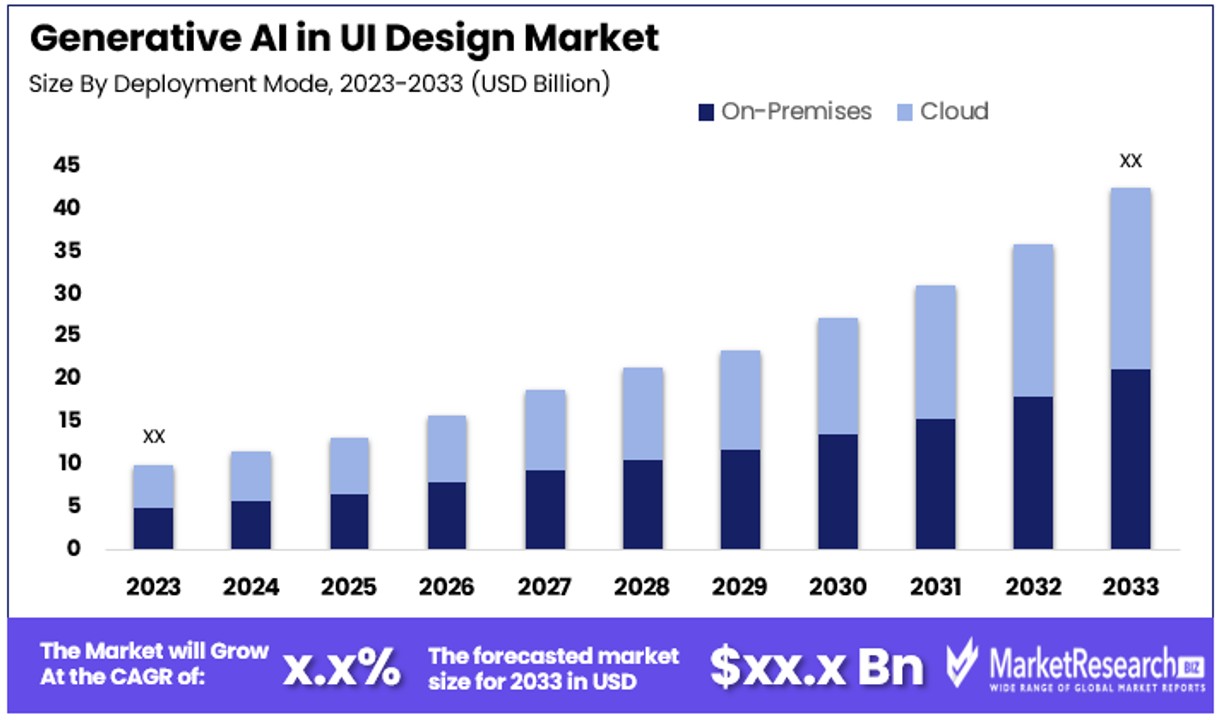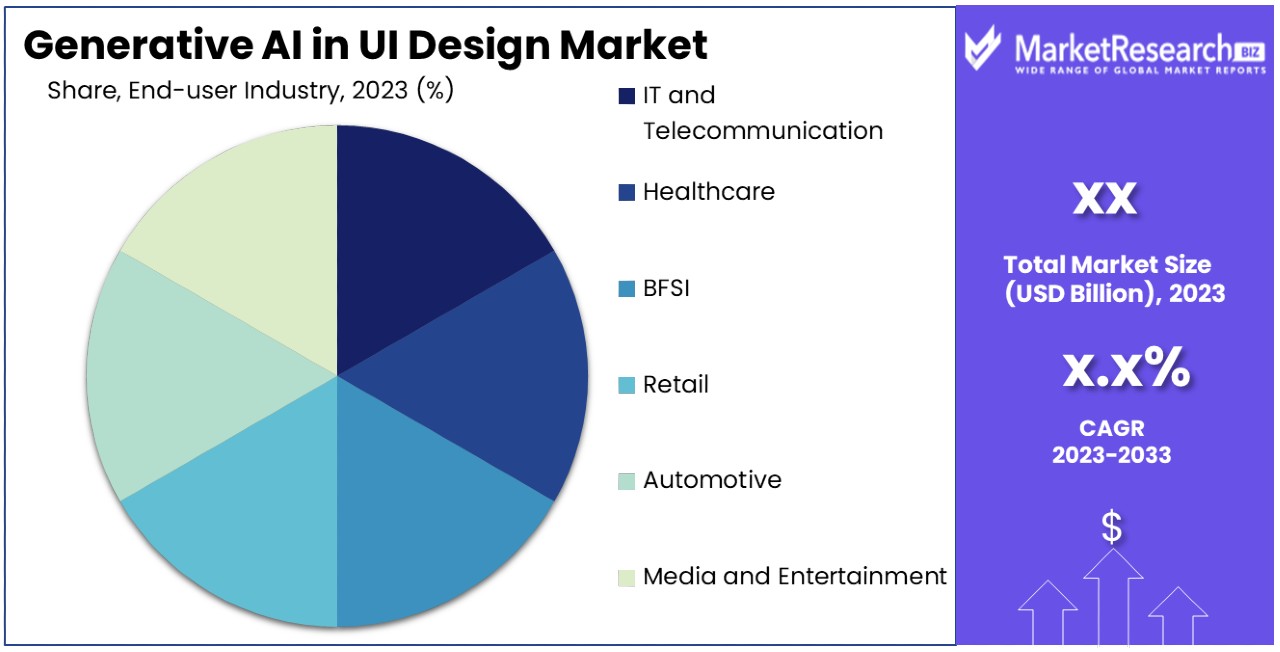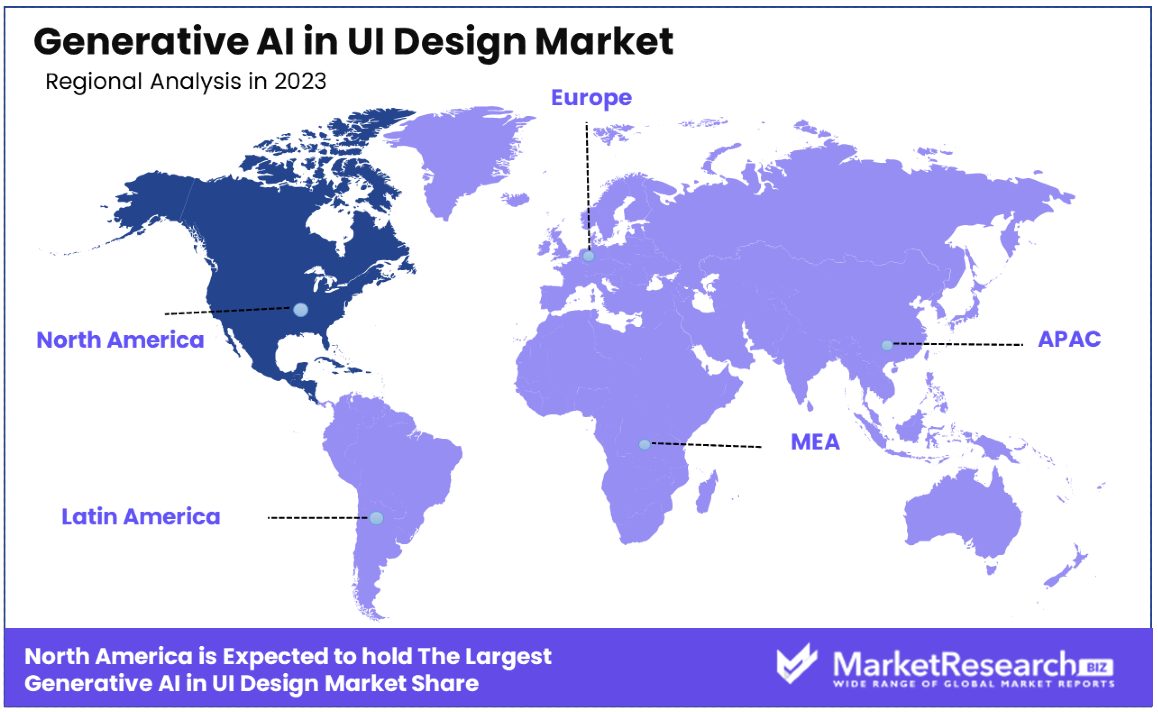
Generative AI in UI Design Market Report By Deployment Mode (Cloud-based, On-premises), By Application (User Interface Design, User Experience (UX) Design), By End-user Industry (IT and Telecommunication, Healthcare, BFSI, Retail, Automotive, Media and Entertainment, Other End-user Industries)By Region and Companies - Industry Segment Outlook, Market Assessment, Competition Scenario, Trends and Forecast 2024-2033
-
44170
-
March 2024
-
160
-
-
This report was compiled by Correspondence Linkedin | Detailed Market research Methodology Our methodology involves a mix of primary research, including interviews with leading mental health experts, and secondary research from reputable medical journals and databases. View Detailed Methodology Page
-
Report Overview
The Global Generative AI in UI Design Market size is expected to be worth around USD xx Billion by 2033, from USD xx Billion in 2023, growing at a CAGR of xx.x% during the forecast period from 2024 to 2033.
The surge in demand for the new advanced technologies and rise in designing are some of the main key driving factors for the generative AI in UI design. Generative AI in the UI design defines as the advanced technologies that uses machine learning algorithms to autonomously build user interface elements, designs prototypes and layouts.

It uses deep learning methods to analyse user behaviour, choice and trends by making the generation of innovative and customized user experience. Generative AI streamlines the UI design process by automating monotonous tasks like layout generations, color scheme selection and content arrangement by making consistency and coherence all across various platforms and devices.
In the UI design market, generative AI simplifies quick rapid prototyping by permitting designers to discover different design variations quickly. It also encourages designers to experiment with novel concepts and iterate designs related to real-time user insights by leading to more user-centric and engaging interface.
Moreover, generative AI improves integration between designers and developers by producing code snippets and designs assets, thereby accelerating the implementation methods. Generative AI transforms UI design by combining more creativity with automation by resulting in more effective work productivity, enhanced design quality and improves user satisfaction.
Generative AI in UI designs provides many advantages and trends that transforms the industry. It fastens the design process by automating monotonous tasks such as layout creation and content generation by making designers to aim on creativity and innovations. It also simplifies customized user experiences by analysing user data and choices by leading to more précised customized interface.
Moreover, it also encourages inclusivity by producing designs that provides to multiple user requirements like accessibility features. Additionally, this trends towards unified integration of generative AI equipments into present design workflows by improving integration and efficacy among the design teams.
Along with the surge of augmented and virtual reality interface, generative AI is up surging used to developed immersive and interactive experience. Lastly, AI continues to march forward, there is a rising emphasis on ethical design principles to make sure fairness, translucent and accountability in UI design methods.
The generative AI in transforming UI designs encouraging designers by enhancing user experience and propels new innovative in the field. The demand for the generative AI in UI design will increase due to its requirement in different designing industries that will help in market expansion in the coming years.
Key Takeaways
- Market Value: The Global Generative AI in UI Design Market is forecasted to reach USD xx Billion by 2033, exhibiting significant growth from its 2023 value, with a CAGR of xx.x% during the forecast period from 2024 to 2033.
- Dominant Segments:
- Deployment Mode Analysis: Cloud-based Solutions: Emerges as the dominant deployment mode, driven by scalability, flexibility, and cost-efficiency, catering to organizations of all sizes seeking advanced computational resources and seamless updates.
- Application Analysis: UI Design: Dominates as the primary sub-segment, leveraging Generative AI to streamline the creation of visually appealing and functional interfaces, significantly reducing design time and effort.
- Regional Analysis:
- North America: Dominates with a 44% market share, fueled by digital innovation and robust adoption of Generative AI in UI design.
- Europe: Holds approximately 27% market share, supported by a conducive regulatory environment and emphasis on digital transformation.
- Analyst Viewpoint: The market's growth is propelled by the increasing demand for innovative, user-centric designs across industries. Opportunities lie in advancing AI capabilities, expanding application areas, and addressing industry-specific design challenges to enhance competitiveness and user satisfaction.
- Market Key Players: Major players include Adobe, Figma, OpenAI, Sketch, InVision, Supernova, RunwayML, Modulate.ai, and others, driving innovation and adoption of Generative AI tools for UI design, catering to diverse industry needs and design requirements.
Driving Factors
Rapid Prototyping and Wireframing Accelerates Design Efficiency
Generative AI significantly streamlines the UI design process by enabling rapid prototyping and wireframing, potentially halving the prototyping and development budget. This technology allows for the quick generation of UI prototypes, wireframes, and design concepts from textual descriptions, user requirements, or existing designs.
Such efficiency not only accelerates the design process but also facilitates faster iterations and feedback cycles, crucial for developing user-centric designs. By reducing the time and resources spent on early-stage design, companies can allocate more efforts towards refinement, testing, and other critical projects. This shift towards more efficient design workflows positions Generative AI as a key driver in the growth of the UI design market, offering significant cost and time savings.
Personalized and Adaptive UI Designs Enhance User Experience
Generative AI's ability to analyze user data, preferences, and behavior to generate personalized and adaptive UI designs marks a leap forward in enhancing user experiences. Tailoring UI designs to individual users or segments ensures a more engaging and intuitive interaction, potentially increasing user satisfaction and loyalty.
This personalized approach not only meets but anticipates user needs, setting a new standard for user interface design. As businesses strive to provide more customized experiences, the demand for Generative AI in creating adaptive designs is expected to rise, contributing to the growth of the UI design market.
Design Exploration and Ideation Foster Creativity
The application of Generative AI in design exploration and ideation offers designers a powerful tool for creativity. By generating a wide range of design concepts and variations, Generative AI enables designers to explore multiple ideas and approaches quickly. This capacity to rapidly produce diverse designs not only enhances the creative process but also encourages innovation within the design community.
The ability to explore various design possibilities without the constraint of time or resource limitations is a significant advantage, driving the adoption of Generative AI in the UI design market. As the industry continues to value innovation and creativity, Generative AI's role in facilitating design exploration and ideation will remain a key factor in its growth.
Restraining Factors
Intellectual Property and Copyright Concerns Restrain Market Growth
The adoption of Generative AI in UI design encounters significant barriers due to intellectual property (IP) and copyright issues. As these AI models are trained on extensive datasets that include existing designs and graphics, there's a high risk of unintentionally incorporating copyrighted elements into their outputs. This situation poses potential legal risks and IP disputes for UI designers and companies. The complexity of determining the ownership and attribution of AI-generated designs amplifies these concerns.
Notably, in response to these challenges, entities such as Getty Images and other stock photo agencies took measures in 2022, including the prohibition of AI-generated image uploads and sales, highlighting the industry's growing apprehension towards IP infringement risks. This legal uncertainty directly impacts the market's expansion, as companies may hesitate to integrate Generative AI into their design processes, fearing potential litigation and copyright infringement.
Lack of Creative Control and Design Authenticity Restrains Market Growth
The integration of Generative AI in UI design is scrutinized for its impact on creative control and design authenticity. Although capable of producing a vast array of design concepts, Generative AI models often fall short of replicating the nuanced understanding and creative intuition inherent to human designers. This limitation can result in the creation of generic or uninspired designs that do not effectively convey a company’s unique brand identity or meet specific user experience objectives.
Moreover, the potential for these AI models to perpetuate biases or stereotypes present in their training data introduces a risk of generating designs that may be deemed insensitive or inappropriate for particular audiences or cultural contexts. The consequence of such limitations is twofold: it not only undermines the value and appeal of AI-generated designs but also curtails market growth by dissuading businesses from adopting AI technologies that cannot reliably meet diverse and complex design requirements.
Deployment Mode Analysis
In the Generative AI in UI Design Market, the deployment mode is a critical factor that influences adoption and integration within various industries. Among the deployment modes, cloud-based solutions stand out as the dominant sub-segment. This dominance is primarily due to the scalability, flexibility, and cost-efficiency that cloud-based platforms offer.
Organizations, ranging from startups to large enterprises, are increasingly relying on cloud services to deploy Generative AI tools for UI design, driven by the ease of access to advanced computational resources and the ability to scale operations according to demand. Cloud-based deployment enables seamless updates and improvements, ensuring that the latest AI models and features are readily available to designers and developers.
On-premises deployment, while less dominant, plays a crucial role in markets where data security, compliance, and control over the AI models are paramount. Industries such as BFSI (Banking, Financial Services, and Insurance) and healthcare, which handle sensitive data, often prefer on-premises solutions despite the higher initial costs and complexity in management. This approach ensures that all data processing and AI operations occur within the secure confines of the organization's infrastructure, offering greater control and minimizing external risks.
Application Analysis
Within the Generative AI in UI Design Market, applications can be broadly categorized into User Interface (UI) Design and User Experience (UX) Design. UI Design emerges as the dominant sub-segment, leveraging Generative AI to create visually appealing and functional interfaces efficiently. This application of Generative AI revolutionizes the way designers conceptualize and implement UI elements, enabling the rapid generation of design variants and facilitating decision-making processes. The ability of AI to analyze vast datasets and produce designs based on best practices significantly reduces the time and effort required in the design phase, thus speeding up the development cycle.
UX Design, while not the dominant segment, is increasingly gaining importance as businesses recognize the value of creating user-centric products and services. Generative AI in UX Design focuses on optimizing how users interact with and experience a product or platform. This includes using AI to analyze user feedback, behavior patterns, and preferences to inform design decisions that enhance usability, accessibility, and satisfaction. The integration of Generative AI in UX design is crucial for developing intuitive and engaging user experiences, a factor that directly influences customer retention and brand loyalty.
The dominance of UI Design is attributed to the immediate visual impact and efficiency improvements it offers in the design process. However, the role of UX Design in driving growth cannot be understated, as it directly contributes to creating products that meet and exceed user expectations. Together, these segments represent a comprehensive approach to leveraging Generative AI in enhancing both the aesthetic and functional aspects of user interfaces, indicating a holistic market trend towards the adoption of AI-driven design methodologies across industries.
End-user Industry Analysis
The Generative AI in UI Design Market finds its applications across a wide range of end-user industries, with IT and Telecommunication taking the lead as the dominant sub-segment. This industry's rapid adoption of Generative AI for UI design is driven by the constant need for innovation, the demand for efficient design processes, and the competitive advantage gained through superior user interfaces.
IT and Telecommunication companies are at the forefront of integrating advanced technologies to enhance their offerings, making them prime users of Generative AI tools for UI design. These tools allow for the quick iteration of design concepts, testing, and deployment, essential in a sector characterized by fast-paced technological advancements and consumer demands.
Other significant end-user industries include Healthcare, BFSI, Retail, Automotive, Media and Entertainment, among others. Each of these sectors contributes to the growth of the Generative AI in UI Design Market in unique ways, driven by their specific needs and the benefits AI-driven design brings to their operations.
For instance, in healthcare, the emphasis is on creating user interfaces that can simplify complex data for patients and medical professionals alike. In retail, the focus is on enhancing customer engagement through personalized and interactive interfaces. Similarly, the automotive industry leverages AI for designing more intuitive and user-friendly in-vehicle systems.
The broad adoption across various industries underscores the versatility and adaptability of Generative AI in meeting diverse design requirements. While IT and Telecommunication remain the leading end-users, the continuous growth in other sectors highlights the expansive potential of Generative AI in UI Design. This trend is indicative of the increasing recognition of the value that intelligent, data-driven design processes bring to enhancing product usability, customer satisfaction, and competitive positioning across the global market.

Key Market Segments
By Deployment Mode
- Cloud-based
- On-premises
By Application
- User Interface Design
- User Experience (UX) Design
By End-user Industry
- IT and Telecommunication
- Healthcare
- BFSI
- Retail
- Automotive
- Media and Entertainment
- Other End-user Industries
Growth Opportunities
Rapid Prototyping and Wireframing Offers Growth Opportunity
The integration of Generative AI into the UI design process presents substantial growth opportunities through rapid prototyping and wireframing. This technology enables the swift generation of UI prototypes, wireframes, and design concepts from textual descriptions, user requirements, or existing designs. The traditional UI design process, known for its time-consuming iterations and revisions, benefits immensely from the acceleration that Generative AI provides.
By rapidly translating design requirements or concepts into visual representations, Generative AI allows designers to explore various ideas, solicit feedback, and refine designs with unprecedented efficiency. This capability not only streamlines the design workflow but also significantly reduces the time to market for new software applications and updates. The ability to quickly iterate design concepts addresses the critical industry need for speed and flexibility in the development cycle, marking a pivotal shift towards more agile and responsive design methodologies.
Design Exploration and Ideation Offers Growth Opportunity
Generative AI's capability to generate a wide array of UI design concepts and variations presents significant opportunities for growth in the realm of design exploration and ideation. Designers, often tasked with the challenge of innovating within the confines of user expectations and technological limitations, find in Generative AI a powerful tool to expand their creative horizons.
By providing access to an extensive range of design possibilities, Generative AI fosters creativity and innovation, enabling designers to break free from traditional constraints and explore uncharted territories in UI design. This exploration not only enhances the quality and effectiveness of UI designs but also propels the industry forward by setting new standards for user interaction and experience. The ability of Generative AI to inspire new creative directions and innovative solutions is instrumental in developing more engaging and effective UI designs, thereby driving market expansion.
Trending Factors
Design System Generation and Consistency Are Trending Factors
The capability of Generative AI to ensure design system generation and consistency is a key trending factor in the UI Design Market. By analyzing existing design systems, Generative AI models generate consistent UI components, thereby maintaining visual and interaction consistency across various platforms and applications.
This trend is particularly significant as businesses strive to offer cohesive and recognizable user experiences across their digital offerings. The challenge of maintaining consistency grows with the scale and evolution of design systems. Generative AI’s ability to adhere to established design systems while generating new UI elements positions it as an invaluable tool for designers. This trend not only enhances user experience but also streamlines the design process, making it a focal point of interest in the market.
Accessibility and Inclusive Design Are Trending Factors
Accessibility and inclusive design, facilitated by Generative AI, are trending factors in the Generative AI in UI Design Market. Generative AI models prioritize creating UI designs that are accessible and inclusive, taking into account the diverse needs and preferences of users, including those with color blindness, vision impairments, and cognitive disabilities.
The emphasis on designing for accessibility and inclusivity is driven by the essential need to create user interfaces that are engaging and usable for everyone. By analyzing accessibility guidelines and user data, Generative AI enables the generation of UI designs that meet high standards of accessibility and cater to a wide range of user needs. This focus on inclusivity is not only a reflection of ethical design principles but also aligns with broader market trends towards creating universally accessible digital environments.
Regional Analysis
North America Dominates with 44% Market Share
North America's prominent position in the Generative AI in UI Design Market, holding a 44% market share, can be attributed to several key factors. This region’s leadership stems from its strong technological infrastructure, concentration of leading tech companies, and substantial investments in AI and innovation. The presence of global tech giants, along with a robust ecosystem of startups focused on AI technologies, fuels advancements and adoption of Generative AI in UI design.
Regional dynamics, such as the high demand for innovative and efficient UI/UX design solutions across various industries, including tech, healthcare, and finance, further reinforce North America's dominance. The region's openness to adopting new technologies and the significant focus on enhancing user experience contribute to the thriving Generative AI market.
North America is expected to maintain its influence on the global Generative AI in UI Design Market. Continued investments in AI research and development, coupled with the growing emphasis on personalized and engaging user interfaces, suggest that North America will remain a key player. This leadership is likely to spur further innovations and set trends in the Generative AI space.

For other regions, their market share and growth rates are as follows:
- Europe: Holds approximately 27% of the market share, driven by its strong emphasis on digital innovation and supportive regulatory environment for AI technologies.
- Asia Pacific: With a 20% market share, this region showcases rapid growth due to its expanding digital infrastructure, rising tech adoption among SMEs, and significant investments in AI and technology development.
- Middle East & Africa: Accounting for around 5% of the market share, the region is witnessing gradual growth with increasing digital transformation efforts and investments in tech sectors.
- Latin America: Holds a 4% market share, with growth influenced by digitalization trends, emerging tech startup ecosystems, and increasing interest in AI applications across industries.
Key Regions and Countries
- North America
- The US
- Canada
- Mexico
- Western Europe
- Germany
- France
- The UK
- Spain
- Italy
- Portugal
- Ireland
- Austria
- Switzerland
- Benelux
- Nordic
- Rest of Western Europe
- Eastern Europe
- Russia
- Poland
- The Czech Republic
- Greece
- Rest of Eastern Europe
- APAC
- China
- Japan
- South Korea
- India
- Australia & New Zealand
- Indonesia
- Malaysia
- Philippines
- Singapore
- Thailand
- Vietnam
- Rest of APAC
- Latin America
- Brazil
- Colombia
- Chile
- Argentina
- Costa Rica
- Rest of Latin America
- Middle East & Africa
- Algeria
- Egypt
- Israel
- Kuwait
- Nigeria
- Saudi Arabia
- South Africa
- Turkey
- United Arab Emirates
- Rest of MEA
Key Players Analysis
In the Generative AI in UI Design Market, major players such as Adobe, Figma, and OpenAI hold significant influence, leveraging AI to transform user interface (UI) design processes. These companies have strategically positioned themselves as leaders in the market, driving innovation and setting industry standards.
Adobe, with its Creative Cloud suite, integrates generative AI tools to enhance UI design capabilities, empowering designers to create visually stunning and user-friendly interfaces efficiently.
Figma provides collaborative design software that incorporates AI-driven features, enabling teams to streamline workflows and create cohesive UI designs seamlessly.
OpenAI plays a crucial role in advancing the field of generative AI, providing cutting-edge models and tools that designers can leverage to explore new design possibilities and iterate on concepts rapidly.
Other prominent players like Sketch, InVision, and Supernova contribute to the market by offering specialized AI-powered solutions tailored to UI design needs, enhancing productivity and creativity for design teams.
Emerging players such as RunwayML and Modulate.ai introduce innovative AI technologies that further expand the possibilities in UI design, fostering creativity and efficiency in the creation of digital interfaces.
Together, these key players shape the landscape of UI design through the widespread adoption of generative AI technologies, driving innovation, efficiency, and creativity in the creation of digital experiences.
Market Key Players
- Adobe
- Figma
- OpenAI
- Sketch
- InVision
- Supernova
- RunwayML
- Modulate.ai
- Other Key Players
Recent Developments
- On March, 2024, Apple's iOS 18 is anticipated to bring significant advancements in AI features, a new user interface, and compatibility with a wide range of devices. This upcoming update is expected to introduce groundbreaking AI capabilities, potentially revolutionizing user interactions and experiences on iPhones.
- On October, 2023, Adobe released new AI models focused on enhancing graphic design capabilities. These models, part of Adobe's Firefly generative AI brand, include Firefly Image 2, Firefly Vector, and Firefly Design.
- On May, 2023, Encora, a global next-gen product engineering provider, unveiled its new Generative AI technology practice aimed at driving increased productivity, higher-quality software, and better market fit for clients worldwide. This initiative signifies Encora's commitment to leveraging Generative AI to accelerate technological innovation across the value chain.
Report Scope
Report Features Description Market Value (2023) USD xx Billion Forecast Revenue (2033) USD xx Billion CAGR (2024-2033) xx.x% Base Year for Estimation 2023 Historic Period 2018-2023 Forecast Period 2024-2033 Report Coverage Revenue Forecast, Market Dynamics, Competitive Landscape, Recent Developments Segments Covered By Deployment Mode (Cloud-based, On-premises), By Application (User Interface Design, User Experience (UX) Design), By End-user Industry (IT and Telecommunication, Healthcare, BFSI, Retail, Automotive, Media and Entertainment, Other End-user Industries) Regional Analysis North America - The US, Canada, & Mexico; Western Europe - Germany, France, The UK, Spain, Italy, Portugal, Ireland, Austria, Switzerland, Benelux, Nordic, & Rest of Western Europe; Eastern Europe - Russia, Poland, The Czech Republic, Greece, & Rest of Eastern Europe; APAC - China, Japan, South Korea, India, Australia & New Zealand, Indonesia, Malaysia, Philippines, Singapore, Thailand, Vietnam, & Rest of APAC; Latin America - Brazil, Colombia, Chile, Argentina, Costa Rica, & Rest of Latin America; Middle East & Africa - Algeria, Egypt, Israel, Kuwait, Nigeria, Saudi Arabia, South Africa, Turkey, United Arab Emirates, & Rest of MEA Competitive Landscape Adobe, Figma, OpenAI, Sketch, InVision, Supernova, RunwayML, Modulate.ai, Other Key Players Customization Scope Customization for segments, region/country-level will be provided. Moreover, additional customization can be done based on the requirements. Purchase Options We have three licenses to opt for: Single User License, Multi-User License (Up to 5 Users), Corporate Use License (Unlimited User and Printable PDF) -
-
- Adobe
- Figma
- OpenAI
- Sketch
- InVision
- Supernova
- RunwayML
- Modulate.ai
- Other Key Players




